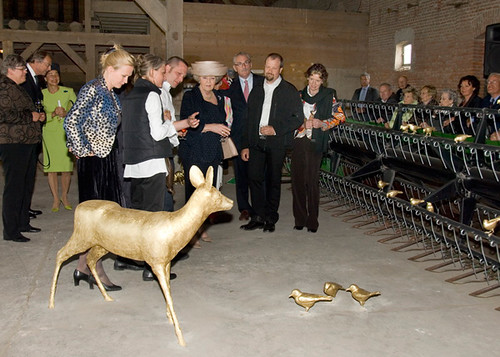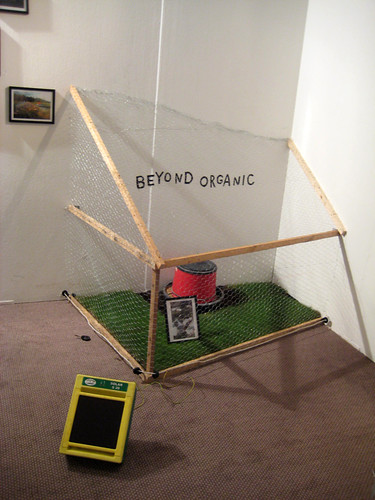
 info
info
Land, art in the Zeeland Wilhelminapolder presents an exhibition in art station Hongersdijk focussing on man in relation to the surrounding landscape. The occasion for the exhibition is the 200th anniversary of the
Royal Wilhelmina Polder Society (De KMWP). Works of art by Maartje Korstanje, Kultivator, Dirk Zoete, Eva Fiore Kovakovsky and Tue Greenfort are on show from 25 April in the Hongersdijk farmstead. Organised by
SKOR and
CBK Zeeland Kultivator will make a work consisting of four parts for the Wilhelmina Polder exhibition.We look at future visions and history of the place, by exploring interfaces between people, wildlife and contemporary agriculture. The work can but does not have to be clung together, the different parts will be: An installation, with working title
”King Midas”, is build up round and including the header of the combine harvester of the farm. On top of the header, and above it in the air, gold coated realistic modelled sparrows and seagulls (common scavengers of the fields) will be positioned. On a distance of a few meters stand a young deer, also realistic modelled coated with gold. (Seemingly made of gold, but in fact covered with a thin gold-like coat)
"Kitchen animals" An audiovisual work combining documentary film sequences from kitchens (people making stamppot) in the Wilhelmina Dorp, with animations of wildlife
"Optional": Possible landscapes. Visions on future and far past landscapes of the polder. Framed montages
"Packages": An experiment in free hand drawing and use of package- and presentation material for the farms produce, foremost potatoes. The drawings/collages will be both separate and made directly onto walls and interior.
overview
”King Midas”
”Optional”
”Kitchen animals”
”Packages”
Land, art in the Zeeland Wilhelminapolder presents an exhibition in art station Hongersdijk focussing on man in relation to the surrounding landscape. The occasion for the exhibition is the 200th anniversary of the Royal Wilhelmina Polder Society (De KMWP). Works of art by Maartje Korstanje, Kultivator, Dirk Zoete, Eva Fiore Kovakovsky and Tue Greenfort are on show from 25 April in the Hongersdijk farmstead. Organised by SKOR and CBK Zeeland
Kultivator will make a work consisting of four parts for the Wilhelmina Polder exhibition.We look at future visions and history of the place, by exploring interfaces between people, wildlife and contemporary agriculture. The work can but does not have to be clung together, the different parts will be:
An installation, with working title ”King Midas”, is build up round and including the header of the combine harvester of the farm.
On top of the header, and above it in the air, gold coated realistic modelled sparrows and seagulls (common scavengers of the fields) will be positioned. On a distance of a few meters stand a young deer, also realistic modelled coated with gold. (Seemingly made of gold, but in fact covered with a thin gold-like coat)
“Kitchen animals” An audiovisual work combining documentary film sequences from kitchens (people making stamppot) in the Wilhelmina Dorp, with animations of wildlife
“Optional”: Possible landscapes. Visions on future and far past landscapes of the polder. Framed montages
“Packages”: An experiment in free hand drawing and use of package- and presentation material for the farms produce, foremost potatoes. The drawings/collages will be both separate and made directly onto walls and interior.
–
[AFG_gallery id=’18’]


Supermarket 2009 artfair where we showed
artist Nick May
and
Farmer Oloph Fritzén
[AFG_gallery id=’17’]

 Participation
Participation
Synaesthetic dinner over the future of food.
Foam, Brussels, Belgium
download the electronic edition of the
"Open Sauces" cookbook in pdf format.

 artist as farmers, and artists’
artist as farmers, and artists’
cultivation projects.
Residency and conference at
The Elterwater Merz Barn
by foundation Littoral, UK.


Linking Culture and agriculture
as a strategy for a meaningful countryside.
more info
. . . . . . . . .
Castle Groeneveld, Baarn, The Netherlands The Groeneveld Forum 2008 is a two-day symposium to explore whether it is possible, or even desirable, to forge a link between culture and agriculture. The question will be examined from different perspectives in workshops and a mock court case. What would be the best way to achieve these links and what are the possible consequences? The changes in agriculture and the rapidly decreasing number of farmers are generally seen as part of a economic transition. But it can also be seen as a cultural transition with serious consequences for the rural area and the relationship between town and countryside. We already see how food production and the experience of landscape and nature are becoming increasingly removed from people's own experience and understanding. Their impression of the countryside has largely been reduced to the mostly nostalgic images produced by marketeers. Many observers now see increasing alienation between people and farming, food and nature. At the same time we see a strong need among people to fing=d some sence of their origin. People want to see coherence instead of isolation, experience wonder at how things grow instead of taking satisfaction from a guarantedd annual yield. Changes in agriculture and the search for our origins are taking place in a global context. Can sustainability, in the sence of respect for nature and invironment, be advanced by re-connecting culture and agriculture? The Groeneveld Forum will form a much needed platform for these themes to be brought to the heart of policy making. On Monday the 10th of November, different workshops will take place. In the workshop New Creative Rural Partnerships Wapke Feenstra gave a lecture on some of her projects ('The Best Place' and 'Former Farmland') related to the subject. Other guest speakers at this workshop were: Fernando Garcia Diaz artist/farmer Plataforma Rural Madrid, Spain Richard Povall Director Aune Head Arts England Malin Vrijman KULTIVATOR Sweden Michael Hart Chairman Rural Cultural Forum England about the host Kasteel Groeneveld is owned by the Ministry of Agriculture and Fisheries. Kasteel Groeneveld now has the task of developing itself into a dynamic outpost of the Minitry; an interface between policy and society. Its most important task is to contribute to the debate on the shaping of the cultural landscape in the Netherlands.





